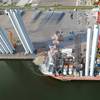Ever Spring is the fifth in a series of ten S-types being built for the Evergreen Group by Mitsubishi. Three have already been delivered to the Evergreen Group’s UK affiliate Hatsu Marine Ltd and a fourth, Hatsu Smile, is due for delivery at the beginning of June.
The honor of cutting the ceremonial rope sending the traditional bottle of champagne against its bow to launch and send Ever Spring on her way down the slipway was given to Mr K C Chang’s wife, Mrs Tseng Chiung-Hui.
The Evergreen Group is taking delivery of 18 large post-Panamax containerships over the period 2005 to 2008 – ten S-types and eight 8063TEU C-types – allowing the Group companies to upgrade existing services and phase out older vessels.
In July 1975, the previous Ever Spring inaugurated the company’s first full container service when she sailed from Taiwan to the US East Coast.
The new S-type vessels are particularly noteworthy in that they incorporate many new environmental features that go well beyond the requirements of new and soon-to-be-introduced international requirements.
Dr Chang believes that all shipowners have a duty to minimise the impact of their operations on the global environment:
“We should not wait for legislation to be introduced. We should use the latest technology as soon as it is available so as to minimise the impact of container shipping operations both on marine life and on port communities.
“Although our market is price-driven and highly competitive, with our customers all seeking to achieve the lowest shipping costs, we know that most of them are also very aware of the environmental issues. We can assure them that Evergreen will provide first-class services whilst maintaining the highest environmental standards.”
The S-class ships incorporate a double-skinned hull and all fuel tanks have been located within the transverse bulkhead spaces, thus minimising the risk of oil pollution or fire as a result of grounding or collision. A high capacity oily water separator enables the oil content of waste water to be reduced below 15 ppm while much larger separator bilge oil and bilge oil holding tanks provide more storage capacity than normal, enabling the vessels to avoid any discharge when sailing in sensitive areas and to maximise the amount of waste that can be held for ultimate disposal in specialised shore facilities.
Similar arrangements have been made for handling sewage and so-called grey water, including water from the cargo hold bilges, when the vessels are in port or close to shore.
The main engines and generators incorporate low NOx technology while the ships are also able to switch to low sulphur fuels when sailing in restricted areas such as the Baltic Sea.
‘Cold-ironing’, the ability to shut down all shipboard generators while in port, switching to shore-based electricity supplies, is also a feature of the S-class vessels. So far, only the Port of Los Angeles has initiated an Alternative Maritime Power (AMP) programme that requires ships to shut down their diesel generators while in port but Evergreen expects many more ports to follow LA’s lead. The Group estimates that the cost of meeting AMP requirements amounts to approximately $2m per vessel.
The latest tin-free anti-fouling systems are also being used for the underwater hull coatings of the S-types and are being applied to other vessels in the Evergreen fleet when they undergo routine drydockings. These new coatings are replacing systems that, although highly efficient and widely used globally, were found to have a negative impact on marine life.
Evergreen has chosen to class those S-class vessels allocated to Hatsu with Lloyd’s Register (LR) while those for operation by Evergreen Marine Corporation will be classed with the American Bureau of Shipping (ABS). It has obtained LR’s EP (environment protection) notation for the Hatsu ships and the equivalent ABS ES (environment safety) notation for the EIS vessels.
With an overall length of 300 metres and a beam of 42.8 metres, the S-class vessels are able to carry containers 17 rows across on deck and 15 rows across below deck. They have a deadweight of 78,700 tonnes on a service draft of 14.2 metres. Each vessel has a single 10-cylinder Mitsubishi Sulzer 10RTA96C main engine developing 74,700bhp (54,900KW) to provide for a service speed of 25.3 knots.
Featured videos

Inside the Electrified Truckable Tug

Tracking Foreign Vessels Working in the U.S. Jones Act Market

Inmarsat Enhances Service to Drive Digitalization
Subscribe for
Maritime Reporter E-News
Maritime Reporter E-News is the maritime industry's largest circulation and most authoritative ENews Service, delivered to your Email five times per week









